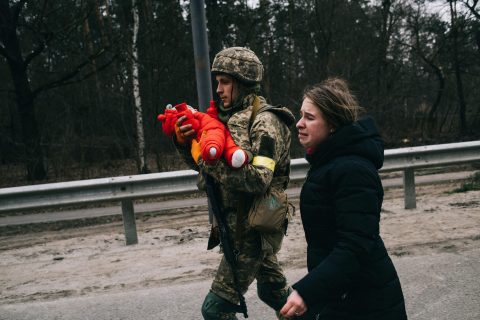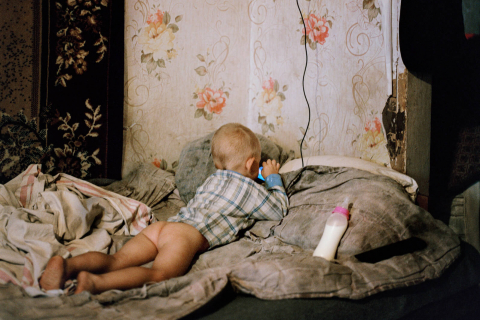
Ten Iconic War Photos of Wolfgang Schwan
Wolfgang Schwan, an American documentary photographer, works with Washington Post, Wall Street Journal, Telegraph, New York Times, New Yorker, National Geographic, Atlantic, Time, and other global media outlets. He has covered the full-scale Russian invasion of Ukraine since its first days. His image of blood-covered Olena Kurylo from Chuguyev has become one of the most recognized photos of the Russian-Ukrainian war.
After the shelling
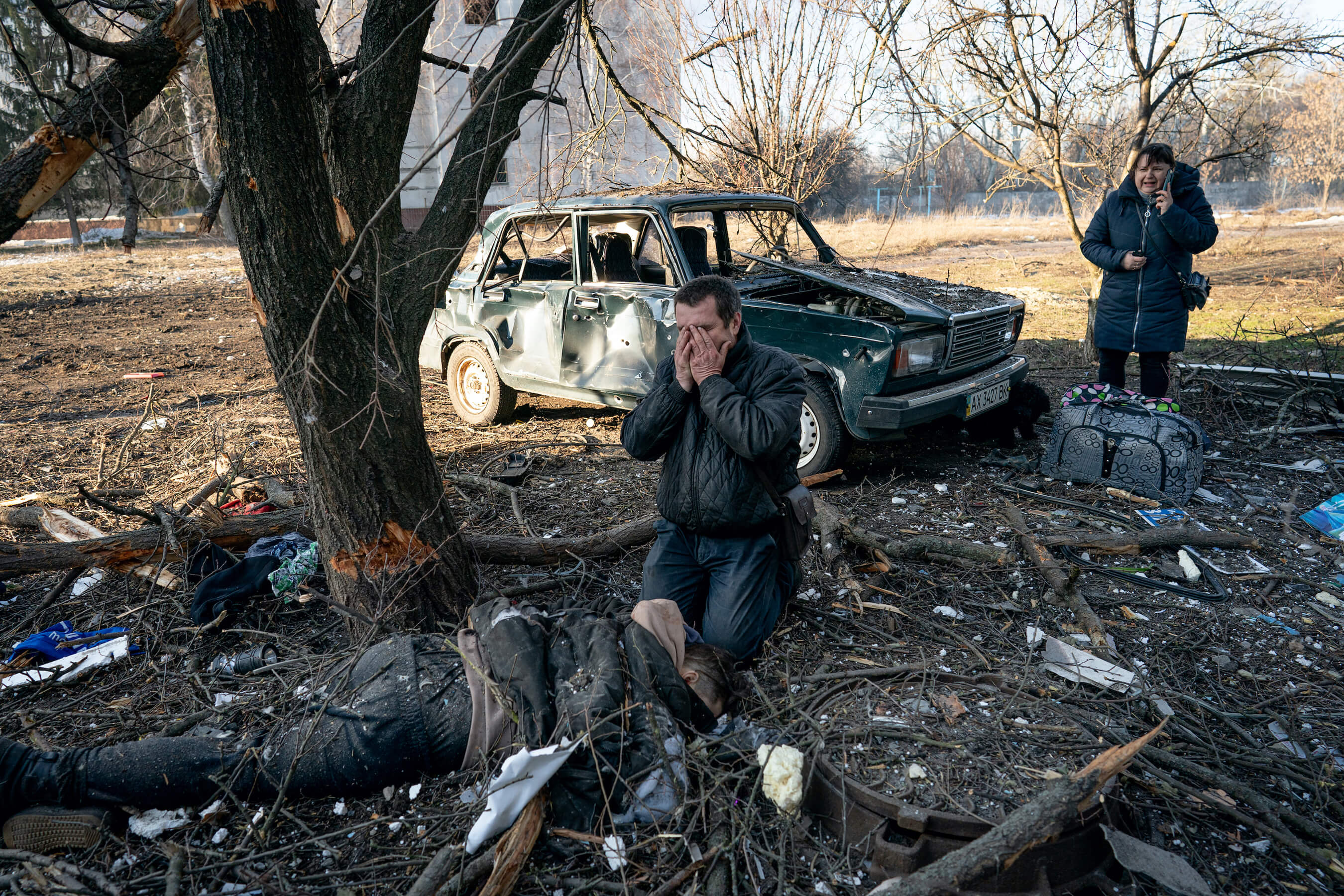
These were the first hours of the full-scale war. I left Bakhmut, where I had spent two months covering the joint forces operation. I headed to Kharkiv first, and then to Kyiv. Back then, I guess, everyone thought that Russia would bulldoze all over Ukraine and seize it straight away. Nobody expected the Ukrainians to resist so effectively. We thought that Kharkiv would fall, so we hurried to Kyiv to cover what we supposed would be the fiercest battle over the capital.
On our way from Bakhmut to Kharkiv, we passed the town of Chuguyev. We saw clouds of smoke. There was a Ukrainian airbase, which Russian troops tried to shell but missed. Instead, their rocket fell between two residential buildings. This man was outside walking when the missile struck. This is a grieving family member, who didn’t want to be named. They didn’t even want to talk to us at all. Their relative was likely one of the first civilian casualties of the war.
The prisoner of war

In this photo, territorial defense guys are carrying out a Russian soldier. It’s happening in Irpin, in the first days of the full-scale invasion. They carried him out of the city and across the bridge and started questioning him. He said he was a soldier and then he was lamenting about the quality of the gear that he had. He had sneakers on that he stole from someone because his boots weren’t waterproof and they were getting wet. I couldn’t stay there longer because the Ukrainian military kicked us out. But I managed to capture the fear on the Russian’s face. At that moment, he had no idea about whatever his destination was going to be.
I think a lot of soldiers on either side consider captivity the last position that they want to be in. At the same time, the Ukrainians are doing a big push to try to incentives Russians to surrender. As far as I know, quite a few of them call a special hotline and turn themselves in. But then there is another danger — they might be turned back over, exchanged for Ukrainian POWs, and face the acquisition of surrendering. I think it scares them more than being held captive.
The girl in front of the tank

During springtime, when Russian forces abandoned their efforts in Kyiv, Sumy, and Chernihiv regions, they left behind a lot of destroyed ordinances and vehicles. Once they left, many people started to come back to Ukraine. On their way home people would see these destroyed Russian tanks, which forced them out of their homes to begin with. They became kind of pop-up monuments to the Ukrainians’ courage in defeating the second-strongest army in the world. A lot of people would pull up on the side of a road and take family photos or selfies. Sometimes the kids would play in the tanks and their mothers would take a picture. We stopped there too, a few kilometers away from the turn to Bucha and Irpin, because my translator, Stas, wanted a selfie. Then we saw families, who were doing the same thing, and we poked around for another twenty minutes. That’s how this picture materialized.
This exact scene was kind of fun, but working in Bucha was very difficult. I have this skill of compartmentalizing and using my camera as a barrier between me and traumatizing events. But sometimes, terrible things kick through. There was a situation when we stopped near one of the previously occupied towns north of Bucha. There was a body lying on the side of the road. I went out of the car to document it when another car pulled up. A man ran out of it — it turned out he was the brother of the dead man. That was the first moment he saw the body. Before that, they thought he was missing. It was a very emotionally charged moment.
The church
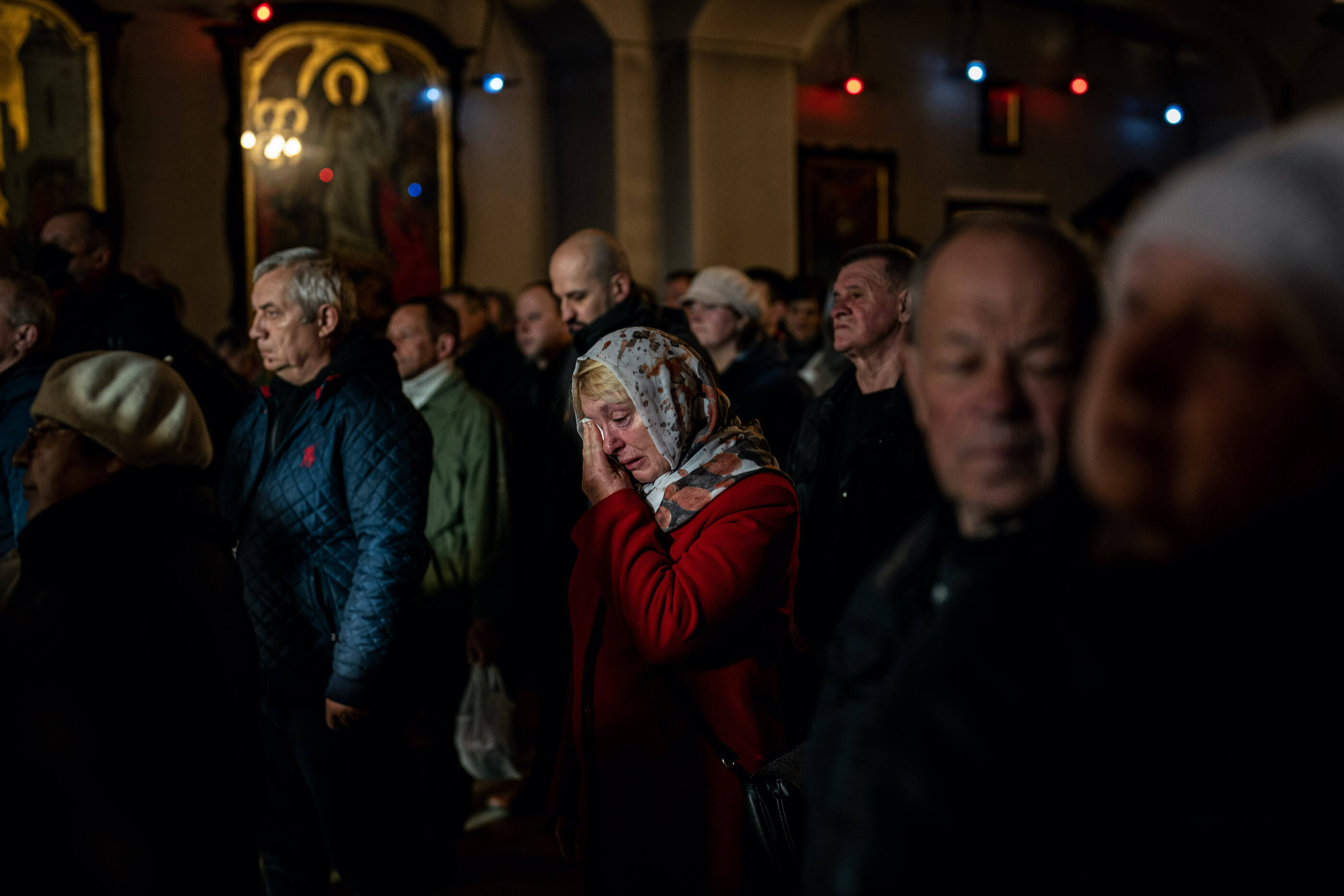
I took this image on Easter in an infamous church in Bucha, where a mass grave was found. That was one of the first times when the community gathered together in that church. There was a lot of emotion there, a lot of crying, a lot of people seeing each other for the first time. And then, there were a lot of photographers there on that day. There is a certain competitiveness among the photographers, which sometimes creates a paparazzi environment. I have gone to one funeral of a soldier very early in the full-scale war and there were so many photographers — they shoved each other, trying to get in the front, and almost knocking over the babushkas. I prefer to have some space to work and be less obtrusive in those intimate moments.
On the other hand, photographers all over the place are getting pushed by editors. For instance, this spring Bucha was the biggest thing for a couple of weeks. And the editors said: “It has to be something in Bucha, I don’t care what it is”. Of course, it was a hugely important story. But the same terrible things have also happened in other occupied towns. Should they have a light shone on them? Of course, they should. Part of the problem was in the laziness of not wanting to go two hours further and talk to people somewhere else. But there were also problems with access. The Ukrainian military administration points out where and what the media can cover. A good example is Kherson. You were not allowed to enter if you were not accompanied by a press officer. Some people tried to sneak in, but as soon as they published their material their accreditation was gone.
Being a freelancer, I can’t risk losing my accreditation. And I completely understand this policy. Ukraine has a war to win. There are certain rules when taking photos of the military: you can’t take photos of vehicle plates or of the horizon line. And those rules exist everywhere. I’ve heard from photographers, who worked in Iraq and Afghanistan, that if you documented a dead US soldier, you were out. Of course, there are things worth the risk. But in general, I try to follow the rules.
The men in Saltivka
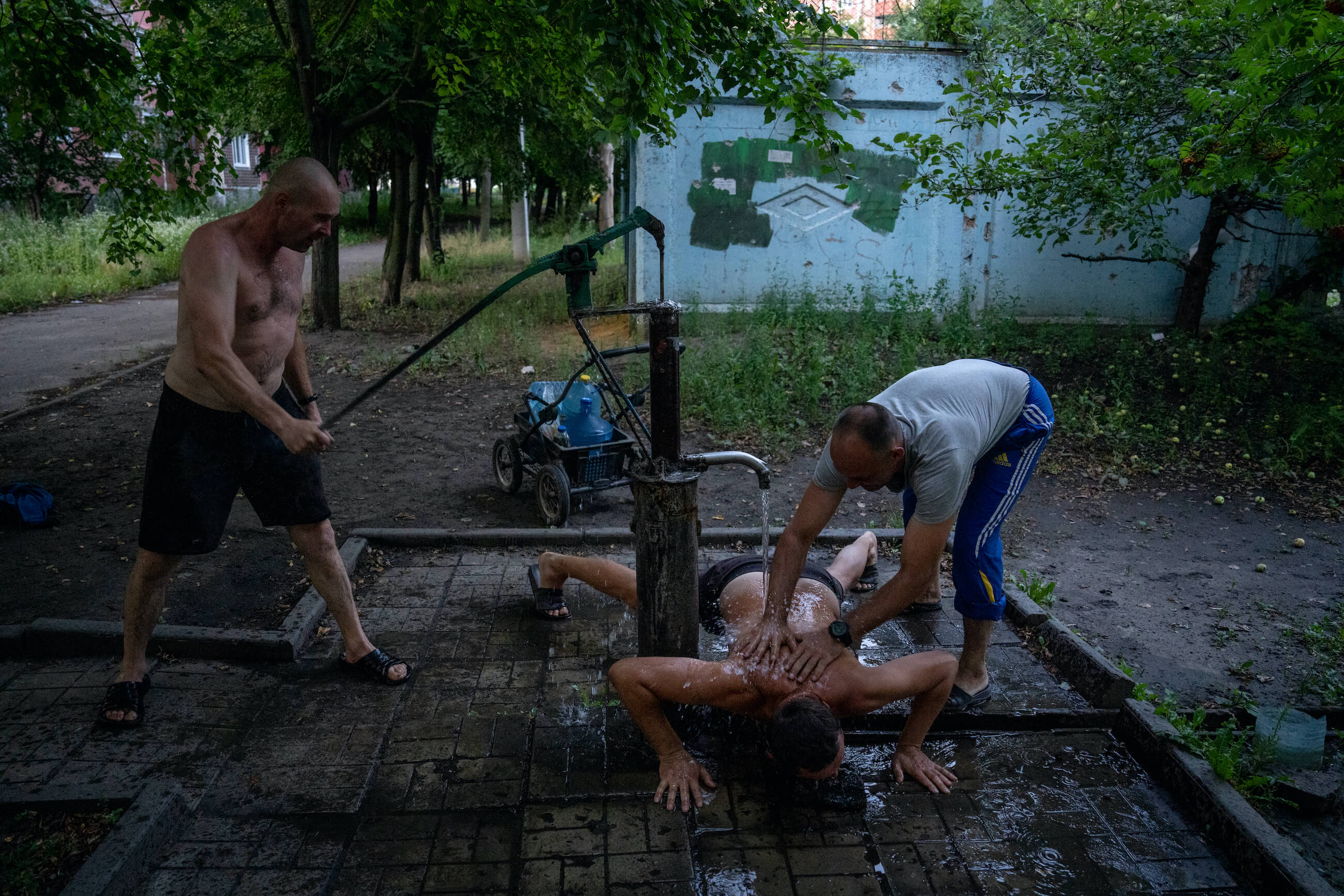
This one was made in Saltivka, in July. This district of Kharkiv has experienced some of the worst shelling in the city for months and months. There were almost no civilians left. We arrived on the northernmost tip of the neighborhood and met these men, who lived in the last three apartment buildings there. Most of the infrastructure, like gas and water, has been destroyed or cut off. When we met these fellas, they were pretty drunk. They invited us to their flats and one of them gave me a little old model of a T-34 tank. Then they wanted to show us how they get water. They all have these water jags in the picture. When we got there, they decided that they were going to bathe underneath the tap. And it was one of those moments when I couldn’t believe I was there with a camera.
When you go to places like Saltivka, you keep having this question in your head, what are people still doing here? It is incredibly dangerous and you can die at any moment. Sometimes the reasons seemed ridiculous. Once we met a woman a bit north of Sloviansk, who refused to go with a police officer who offered her evacuation. She said she had “tomatoes planted last month”. I think in general people refuse to go because they don’t like to rely on someone else, they don’t want to be a burden. They don’t want to go because they lived there their whole life and their family is buried there. The reasons to stay are always different. But at the moment, choosing to stay seems crazy.
The kiss

This was taken in Pokrovsk in the summer when the administration sort of mandated that everyone leaves Donbas. There was a train leaving from Pokrovsk every day at 3 or 4 p.m. and going to Dnipro. And from there, people could go anywhere. The government also offered financial aid, but not much, something like 200 US dollars. That could give people a starting point — to pay for rent or buy groceries.
So, this couple in a railway station is splitting up, hopefully, temporarily. The girl is leaving her home in Kostiantynivka. And the guy is a soldier, he has a three-day leave. He just rotated out of Bakhmut and his unit had taken a lot of casualties. He was worried for her, he was worried for himself. They were saying goodbyes and not knowing if they will ever see each other again.
The bicycles
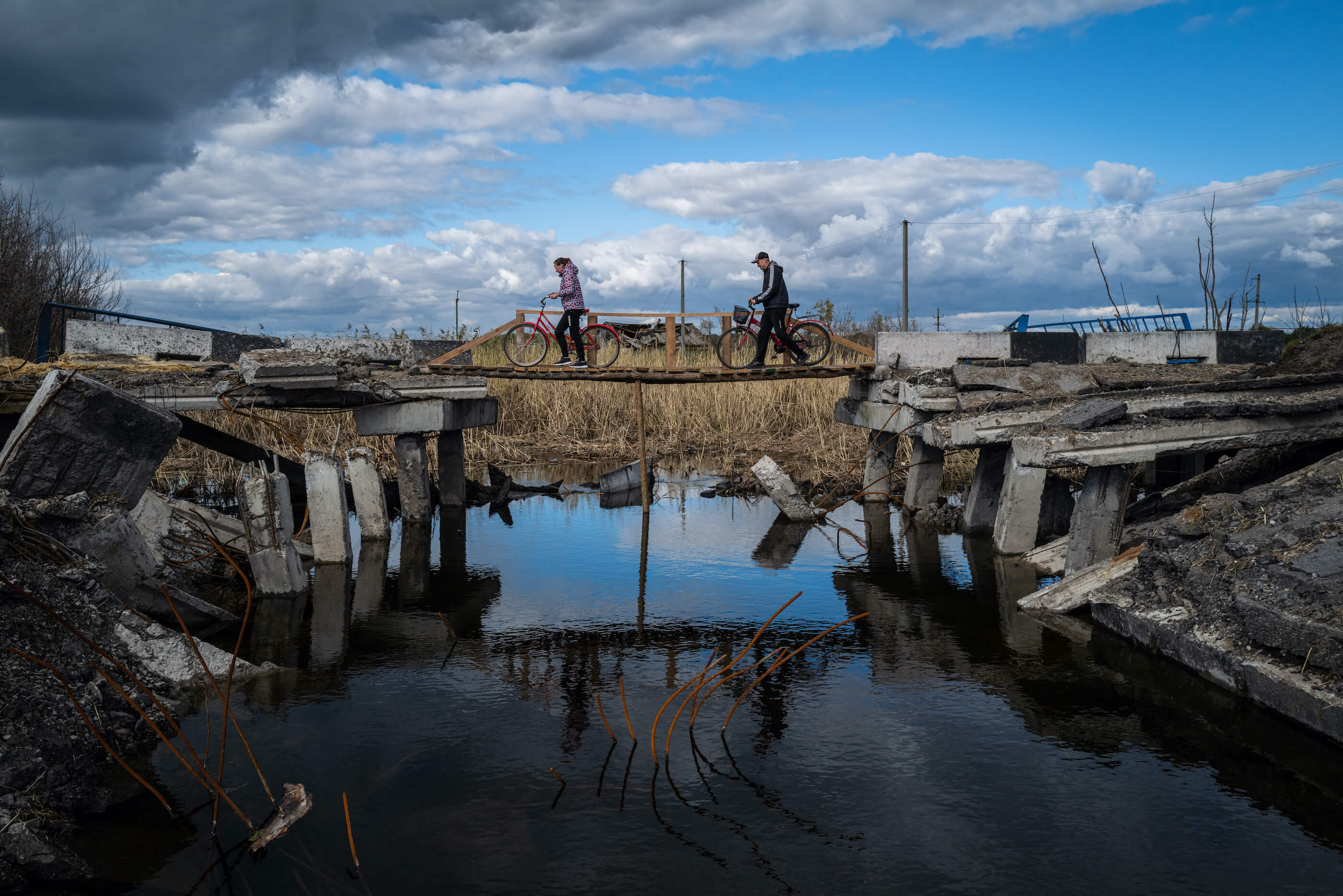
This is a very different photo. Unlike the previous one, where I caught this fleeting moment of a couple kissing, here I had more time to take a picture. My friend Serhiy and I were working in Borova, on the east of the Oskol river, near Izyum. One autumn day we came to the destroyed bridge and sat on a water gas pipe, which was running next to the bridge. We sat there for thirty or forty minutes and we photographed quite a few people crossing. The clouds were changing and the lights created a different image every time. There were a few people that drove over it on motorcycles, but I like this one.
The bridge itself was destroyed by the Ukrainian army to slow down the Russians. I’ve seen a lot of similar pictures in de-occupied Izyum, Lyman, and other cities. With this photo, I tried to show what life after liberation looked like. On paper it sounds great — the Ukrainians have taken back their land. But in reality, people have to ride their bikes around the town because there is no way to drive their cars. Some of them still had no electricity and heating, some were still living in their basements. Liberation isn’t the end of people’s suffering.
The legs
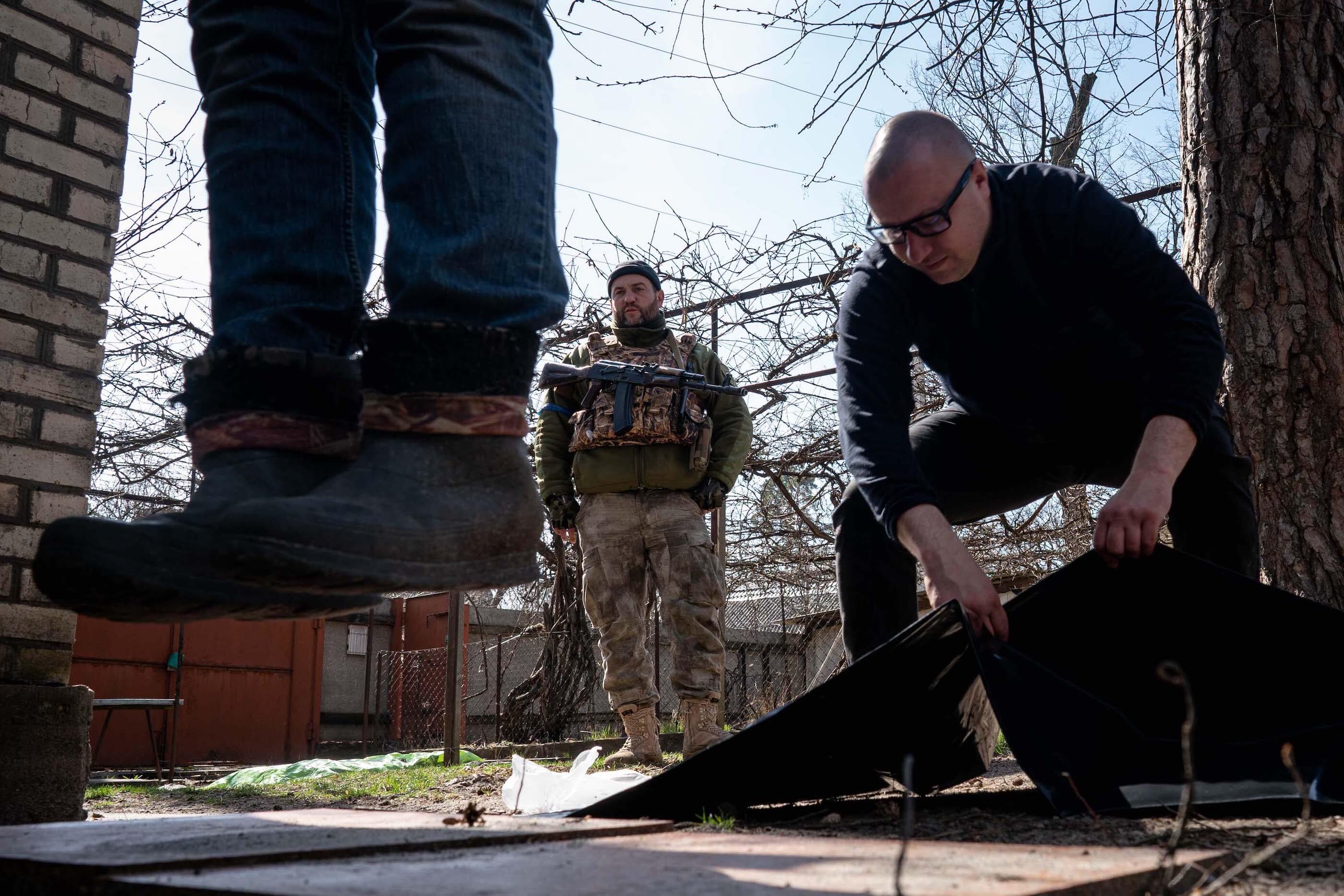
This was an elderly woman, who hung herself in Bucha. The man on the right is a volunteer, who was collecting bodies during the whole occupation. I tagged along with him for two days. He would get a call from territorial defense, saying that they had located a body. Then he would come, put the body in a bag, and write down all the information: the person’s estimated age, how they looked, what they were wearing, what the supposed circumstance of death was. It was needed so that later the body could be identified. Because a lot of people didn’t have their IDs with them. For instance, someone left their home, got under the shelling, and got killed. But how can we know, whether this person lived in the house, near which they are lying, or they just passed the house on their way to somewhere else? This woman had her passport with her. She didn’t leave a note, but I’m sure she had her reasons.
The photo shows the hardships that people were dealing with, the despair and bleakness of life under occupation. Initially, I had a frame of the whole scene, including the woman’s face, but it was too much. I’m not a crime scene photographer, that’s not what people need to see to understand the situation and feel empathy.
The smoke

There is a field fire happening somewhere in Bucha, Irpin, or Hostomel. I took this photo from the roof of one of the high-rise buildings in Kyiv. When we saw the smoke, we went from one apartment building to another, asking the security, hey, would you let us go upstairs, we want to photograph this from the top floor. And one of the security guys eventually said yes. And this was in March, when everyone was super-suspicious, especially if you were a foreigner. There were multiple times when we were pulled out of the car at gunpoint and searched up and down, all our bags getting ripped through. And here we were now, on the roof!
I completely understand their suspicion and mistrust, because their country was invaded. On the other hand, our job was to document the situation. And we had to keep up with the standards. I could have taken the same photo with a cell phone and it would look like shit. There are probably a lot of photos and videos of that smoke online. We can’t compete with social media, it will always be faster. But if you happen to be somewhere when something historically important happens and if you are good at what you do and have your camera with you, you should try to take a picture that will make people stop and look at it. There are a lot of things that you can’t make look beautiful. If you are photographing, let’s say, a military hospital in Bakhmut, you don’t need to try and make it look aesthetically appealing. But you can take a good photo even with a very grim subject that needs to be discussed.
Olena

I made this portrait in Chuguyev, at the very beginning of the full-scale invasion. Olena was one of the first people that we photographed. She just walked towards us, she had some medical care taken of her. We photographed her and asked for her name, profession, and age. The encounter was extremely brief. We carried on covering the scene, she walked toward other first responders. And that’s it.
I met her recently in Poland. She is the most incredible woman. Every drop of attention that she has gotten from the media she uses to ask for support for Ukraine. It is incredible. Her photo went viral and Russian propaganda called it a fake. But she handled it well and she used all of that for the greater good. It doesn’t bother me that my photo is accused of being fake. I’ve been through that since Donald Trump’s presidency. I know that anyone can use my photo, re-write the caption and lie. But it doesn’t mean that something is not worth doing only because someone can misuse it.
I do believe that photography or a single photo has the power to change something. Take Chris Hondros’ photo for example. He took a picture of a little girl, covered in blood, who cried after the US military shot her parents at a checkpoint in Iraq. This photo hugely affected the US domestic perception of the war. Think of Eddy Adams’ photo of an execution of a Viet Cong prisoner. I don’t know about my photo but it helped to show that there will be civilian casualties in this war. I think it’s important. And this is why I’m going back to Ukraine to continue documenting the history.
Photo: Wolfgang Schwan / Anadolu Agency via AFP
New and best
